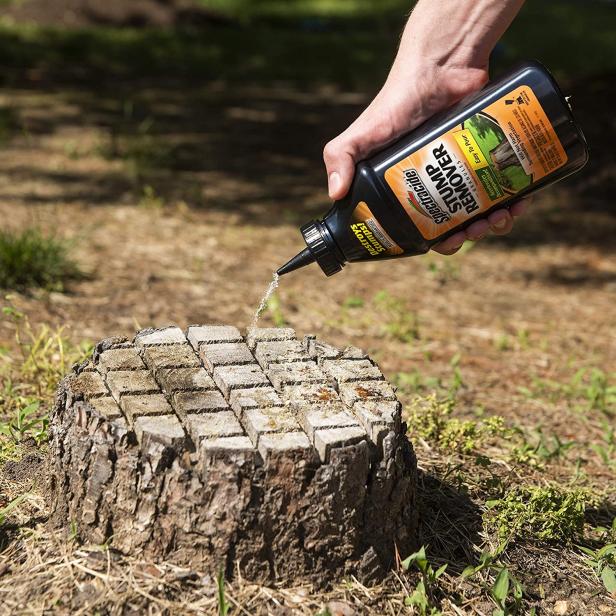Stump removal can be a difficult and expensive task. A tree stump is a prime breeding ground for pests and diseases. Besides the hassle and cost, this is also a potential liability. To avoid such a situation, here are some steps to ensure safe removal. Read on! You may be surprised! Read on to discover the best methods for stump removal. Listed below are some of the benefits of stump removal. We hope this article helps you decide on the best method for your situation.
Chemically removing a stump
There are two main methods for chemically removing a tree stump. One is to use a specialized chemical stump remover. For this method, you need a mixture of glyphosate, triclopyr, or picloram, and the other is to use a chainsaw. You must wear protective gear and follow the manufacturer’s instructions carefully to avoid the risk of inhalation or skin contact. After applying the chemical, it takes several weeks before the stump decomposes naturally. The other method is to remove the stump using a chainsaw and spade.
When using a chemical stump remover, the size of the stump is of great importance. If the stump is more than two to three inches in diameter, it should be manually removed. If the stump is smaller, you should dig it out. Using a chemical stump remover may take years to completely dissolve the stump. In addition, you risk exposing animals and children to toxic chemicals. This is why stump removal should be performed by a professional.
When chemically removing a tree stump, you need to make sure the stump is dead. A dead stump is not a good candidate for chemical removal because it is no longer capable of sending up new shoots. In addition to being hazardous, a dead stump can also impede your landscaping plans. A chemical stump remover will accelerate the decay of old wood. Although this process may take months, you can still burn it once it has partially decomposed.
If you don’t have time to remove the tree stump by hand, you can hire a professional tree surgeon to do it for you. They may recommend chemical treatments as an alternative to burning. A tree surgeon will most likely recommend chemical treatments for tree stump removal, though they may also recommend other methods like eco-plugging. If you’re unsure, consult a tree surgeon. They will be able to advise you on which method will work best.
While a chemical solution may be the safest option, it is not recommended for areas where children and animals are present. Additionally, chemically removing a tree stump may be inconsistent with local law. To burn a stump, you need to drill holes into the ground below the stump and pour in vegetable oil. You will need to watch the fire closely until the tree is completely burned. Once the chemical solution is completely removed from the stump, you can remove the roots and then dig out the rest of the tree.
A highly effective method of chemically eradicating a tree stump is eco-plugging. This method is very effective and does not harm the surrounding trees. Furthermore, eco-plugs are effective year-round and do not harm the surrounding plants. Using an eco-plug can be a great option because it’s safe to use any time of the year, and the herbicide is suitable for many types of trees.

Using a stump grinder for a Stump Removal process
Using a stump grinder is one of the most effective ways to remove a tree stump. Its sharp teeth can quickly remove even the largest of stumps and leave your yard looking better than it did before. However, the stump grinder leaves a large hole in your yard that you will need to fill with soil. If you do not own one of these tools, you can rent one from a local rental company.
To use a stump grinder, drive it to within 3 feet of the stump. Once there, use the hydraulic lever to raise the cutting wheel a few inches above the stump. Position the wheel over the stump and lower it in small passes. Once you have removed enough wood from the stump, you can turn off the machine. If you are using a stump grinder for the first time, be sure to wear safety gear.
Another way to calculate the cost of stump grinding is to measure the diameter of the stump in inches. This measurement takes into account any roots and dirt flare-ups on the stump. Some customers choose to remove the stump so they can plant other trees in the same location. Others want to plant something else in the spot where the tree was removed. Whatever the reason, a stump grinder can help. It can be a cheap and effective way to get rid of a tree stump.
Before you start grinding, make sure you read the manual thoroughly. Ensure that you understand how to operate the stump grinder and what its controls are. Some stump grinders have lever controls or handlebars for operation. You may need to adjust the height and depth of the blade while using it. It takes approximately 45 minutes to grind a 20-inch oak stump. You will need to adjust the blade to the right height before beginning to grind the stump.
Using a stump grinder for tree stump removal can be dangerous if done incorrectly. Careless use of stump grinders can lead to machine damage, flying rocks, or a break in the cutting tips. Even worse, a careless operator could suffer fractures, loss of limbs, or even death. For this reason, safety is your top priority when using a stump grinder. Follow all pre-start checklists and operate your stump grinder in accordance with instructions to prevent any injury to yourself or other people.
Using a stump grinder can be difficult if your tree is uprooted and has large roots above ground. Additionally, the grinder cannot reach all of the tree’s underground materials. Depending on the type of tree, you may end up with a dirtier mess than tree matter. This means that you will have to re-land your yard after the stump grinder is done. This will leave more dirt behind than tree matter and may not be suitable for mulch.
Pests and diseases attracted to tree stumps
Tree stumps are not only unsightly, but they also attract diseases and other pests. If left untreated, these decaying stumps can harbor fungi and other diseases, threatening the health of neighboring plants and trees. Furthermore, these stumps may pose a threat to your home, especially if you have small children or have allergies. To prevent these problems, it is important to get the tree stump removed.
If a tree stump is infected or decayed, it may attract pests, including ants, fungi, and other insects that feed on dead wood. A diseased stump can also spread a fungus or other disease to nearby plants, making removal more difficult. Thankfully, there are several ways to remove tree stumps safely and effectively. Using chemicals, machinery, or hand removal methods is one option, though some are more expensive. In addition to aesthetic value, a tree stump can be used as a planter for perennials or other plants.
If a tree stump is left untreated, it can sprout new growth. These sprouts can be unsightly and a real pain to control. Furthermore, they can also steal nutrients from other plants around the stump. This can make it difficult to make plans to landscape your yard. Ultimately, it can also be unsafe. When you hire a professional tree service, you can rest easy knowing that your tree will be removed safely.
Another major concern for homeowners is the risk of termite colonies. When the tree stump is located near a house, it becomes an easy target for these insects, which can damage your home and cause structural damage. Termites are not only dangerous to your house, but they can also spread to neighboring trees, so stump removal can protect you against these pesky insects. And while stump removal is expensive, it does not have to be.
If you decide to remove the tree stump, it is imperative to do it properly. Proper removal will ensure that your property remains safe and free from hazards, including tripping hazards and dangers from lawnmowers. Depending on your plans for the space, stump removal may be the best option for you. But before you hire a professional, make sure you ask yourself some important questions. For instance, do you want to plant a tree in your yard in the future?
If you’re considering a stump removal project, it’s important to hire a certified arborist. This professional will be able to provide you with the best advice for your situation. During the stump removal process, you should also make sure to prepare the ground so that it doesn’t collapse. In addition, make sure you fill in the hole with loam or sawdust to prevent it from collapsing.

